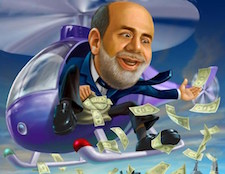 Most people who have undertaken a formal study of economics end up accepting such things as the necessity of a central bank to prevent or at least ameliorate recessions. They take as a given the need for government intervention in the economy, or if not as a given, as explained by countless historical incidents of injustice. Perhaps most of all, they regard anyone calling for an unregulated gold coin standard as so hopelessly backward and naive that refutation becomes a matter of rolling one’s eyes.
Most people who have undertaken a formal study of economics end up accepting such things as the necessity of a central bank to prevent or at least ameliorate recessions. They take as a given the need for government intervention in the economy, or if not as a given, as explained by countless historical incidents of injustice. Perhaps most of all, they regard anyone calling for an unregulated gold coin standard as so hopelessly backward and naive that refutation becomes a matter of rolling one’s eyes.
Everyone “knows” the gold standard fostered those 19th century Panics, which the high-minded bankers finally addressed by creating the federal reserve system in 1913. Under the federal reserve, the government was able to create enough debt to send our boys “Over There” to fight the Hun and die in horrendous numbers. Under the federal reserve, the country experienced “liquidity” for a decade of extravagance in the 1920s. Under the federal reserve, the economy crashed in 1929, the very thing it was supposed to prevent. It attempted to inflate us out of the Depression that followed but, as the story goes, was hamstrung in part by the barbarous relic, gold. This is the reason why President Roosevelt, almost immediately after being elected in 1933, ordered Americans to turn in their gold under threat of fine and imprisonment.
Voila! We now had the Depression without sound money.
 And what has happened since? In a speech before The Economic Club of New York on December 19, 2002, Fed Chairman Alan Greenspan said:
And what has happened since? In a speech before The Economic Club of New York on December 19, 2002, Fed Chairman Alan Greenspan said:
“Although the gold standard could hardly be portrayed as having produced a period of price tranquility, it was the case that the price level in 1929 was not much different, on net, from what it had been in 1800. But, in the two decades following the abandonment of the gold standard in 1933, the consumer price index in the United States nearly doubled. And, in the four decades after that, prices quintupled. Monetary policy, unleashed from the constraint of domestic gold convertibility, had allowed a persistent overissuance of money. As recently as a decade ago, central bankers, having witnessed more than a half-century of chronic inflation, appeared to confirm that a fiat currency was inherently subject to excess.”
But, he went on to say, central bankers are learning to treat the money they print as if it had the restraints of gold, or in his words “a prudent monetary policy . . . can contain the forces of inflation.” This was in 2002, before the economy blew up in 2007-2008 because of Fed money printing.
 The Bernanke solution to the crisis, as the world witnessed, was even more aggressive money printing, creating staggering levels of debt and moral hazard, so that today financial pundits are predicting another crisis, likely worse than the last.
The Bernanke solution to the crisis, as the world witnessed, was even more aggressive money printing, creating staggering levels of debt and moral hazard, so that today financial pundits are predicting another crisis, likely worse than the last.
The Austrian school of economics rejects the need for government in the economy. It goes further: the Austrians maintain that interventions not only fail but are almost always used to justify further interventions to fix the previous failures. This continues at enormous cost and suffering until we find ourselves in the mess we are in today, where Democratic candidates in 2019 openly call for socialism to fix the failures of the free market they have spent decades destroying, along with their partners-in-crime, the Republicans.
Where can someone get a straight story on the item that is involved in virtually every economic transition — money — and how its corruption has led to economic misery and injustice?
One excellent source is Joseph Salerno’s “Money, Sound and Unsound,” available online at Mises Institute or from the Kindle store at a low price.
As Salerno writes in the Introduction:
“[T]he new millennium dawned with the Austrian sound money paradigm thriving—but still ignored by the mainstream. The bursting of the housing bubble and the meltdown of financial markets changed all this. A small number of economists and participants in financial markets forecast these events using the Austrian theory of the business cycle, which gives the only coherent explanation of booms, bubbles, and depressions. Word spread quickly through the banking and financial sector and among the general public via the Internet. Soon several high-profile financial pundits and other members of the official media were publicly recognizing and embracing the Austrian analysis. Even a few mainstream financial economists were stimulated to give it a sympathetic hearing.
“Prominent (and not-so-prominent) mainstream economists were nonplussed, if not alarmed, by this spreading challenge to their authority and attempted to respond to it by engaging Austrian business cycle theory on blogs and in popular periodicals. But these attempts were little more than hysterical diatribes based on a very inadequate knowledge of the literature and a profound misconception of the nature and claims of the theory. In the meantime, the doctrine of sound money, with Austrian monetary and business cycle theory at its core, has continued to flourish and grow and has emerged as the main challenger to the collapsing Keynesian spending paradigm.”
The remainder of his book explains why only a sound money is compatible with sustainable prosperity, individual freedom, and peace.
I highly recommend it.
Note: In my previous article I presented sections of Joseph Salerno’s book with minimal commentary, believing his words needed little or no clarification. I had read reader reviews claiming his writing was abstruse and wanted to offer numerous counter-examples. I believe I succeeded in that goal but at the cost of developing reader interest. I hope this article corrects that deficiency.
Written for George Ford Smith for Barbarous Relic ~ August 12, 2019









